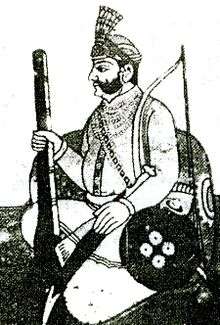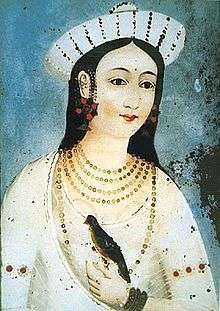Chhatrasal
| Chhatrasal | |
|---|---|
| Maharaja | |
 | |
| Born |
4 May 1649 Kachar Kachnai |
| Died | 20 December 1731 |
| Spouse | Ruhaani Bai |
| House | Bundela |
| Father | Champat Rai |
| Mother | Lal Kunwar |
Maharaja Chhatrasal (4 May 1649 – 20 December 1731), was a medieval Indian warrior from the Bundela Rajput clan, who fought against the Mughal Emperor Aurangzeb, and established his own kingdom in Bundelkhand,[1] becoming the founder of Panna State.
Early life
Chhatrasal was born in Kachar Kachnai on the 4 May 1649, to Champat Rai and Lal Kunwar. He was a descendent of Rudra Pratap of Orchha.[2] His ancestors were vassals of the Mughal emperor.He is the father of Mastani , who is his daughter through his Persian Muslim wife -Ruhaani Bai.
Revolt against the Mughals
Inspired by Chhatrapati Shivaji's advice Chhatrasal raised the banner of revolt against the Mughals in Bundelkhand at the age of 22, with an army of 5 horsemen and 25 swordsmen, in 1671. During the first ten years of his revolt he conquered a large tract of land between Chitrakoot and Panna on the east and Gwalior on the west. His domains stretched from Kalpi in the north to Sagar, Garah Kota and Damoh in the south. Some of the Mughal generals who were defeated by him were Rohilla Khan, Kaliq, Munawwar Khan, Sadruddin, Sheikh Anwar, Sayyid Latif, Bahlol Khan and Abdus Ahmed etc.
Chhatrasal captured Mahoba in 1680. In the second phase of his struggle between 1681 and 1707, Chhatrasal suffered a few reverses.
Alliance with the Marathas

The Maratha Peshwa Baji Rao I's second wife Mastani was Chhatrasal's daughter.[2] In his book Mastani, the historian D. G. Godse states that the relationship between Chhatrasal and Baji Rao I was like that of father and son.
Before his death on the 20 December 1731, Chhatrasal bequeathed Mahoba and the surrounding area to Baji Rao I in return for Baji Rao's assistance against the Mughals.
Patron of literature
Chhatrasal was a patron of literature, and his court housed several noted poets. His eulogies written by Kavi Bhushan, Lal Kavi, Bakhashi Hansaraj and other court poets helped him gain lasting fame.[3]
Religious views
Chhatrasal was a disciple of Mahamati Prannathji and accepted him as his guru and accepted Nijanand Sampraday also known as Pranami Sampraday. Their meeting took place in Mau in 1683, a place near Panna. His nephew Dev Karanji who had met Swami Prannathji, earlier in Ramnagar, was instrumental for this meeting. Chhatrasal was highly impressed of Prannathji and became his disciple. When Maharaja Chhatrasal came to meet him, he was going for a battle against Mughals. Swami Prannathji gave him his own sword and covered his head with a scarf, saying, "You will always be victorious. Diamond mines will be discovered in your land and you will become a great emperor." His prophecy came true and even today Panna region is famous for their diamond mines. Swami Prannathji was not only the religious Guru of Chhatrasal; but he guided him too in political, social, and economic matters. It was by being granted the boon of finding diamonds in Panna by Swami Prannathji that Maharaja Chhatrasal became prosperous.[4][5][6]
Legacy
The Chhatarpur town and its eponymous district in Madhya Pradesh are named after Chhatrasal. Several places in Chhatarpur, including the Maharaja Chhatrasal Museum, are named after him. The Chhatrasal Stadium in Delhi is also named after the Maharaja Chhatrasal. The Royal family still resides in Chhatarpur.
Further reading
- Bhagavānadāsa Gupta, Life and times of Maharaja Chhatrasal Bundela, New Delhi, Radiant (1980). ISBN 1-135-47177-0
- Bhagavānadāsa Gupta, Contemporary Sources of the Mediaeval and Modern History of Bundelkhand (1531-1857), vol. 1 (1999). ISBN 81-85396-23-X.
- "Mastani" by D. G. Godse
- Dharmika Teja, a Kannada language historical novel; the story revolves around Maharaja Chhatrasal's youth
References
- ↑ Sen, Sailendra (2013). A Textbook of Medieval Indian History. Primus Books. pp. 187–188. ISBN 978-9-38060-734-4.
- 1 2 Bundela Rajas of Bundelkhand (Panna)
- ↑ K. K. Kusuman (1990). A Panorama of Indian Culture: Professor A. Sreedhara Menon Felicitation Volume. Mittal Publications. p. 157. ISBN 978-81-7099-214-1. Retrieved 10 December 2012.
- ↑ Pranami Faith : Saints of Pranami Dharma : Texts
- ↑ The Pranami Faith: Beyond `Hindu’ and `Muslim’- Dominique-Sila Khan
- ↑ Identity and religion: foundations of anti-Islamism in India By Amalendu Misra
External links
 Media related to Chhatrasal at Wikimedia Commons
Media related to Chhatrasal at Wikimedia Commons